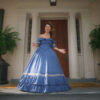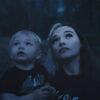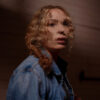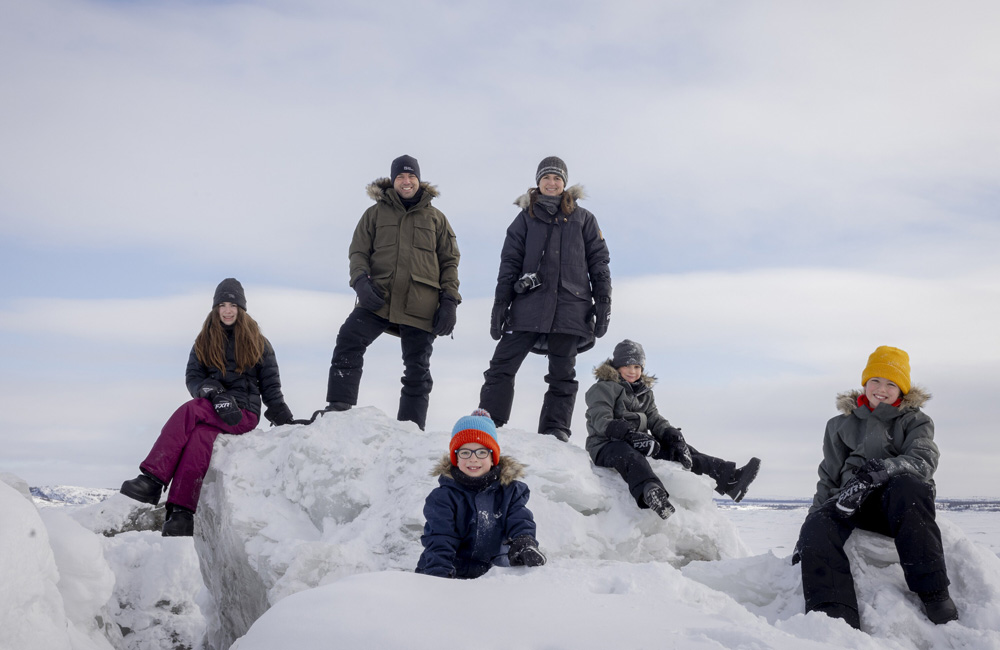“In my head, we’re still traveling,” Sebastien Pelletier says towards the end of “Blink,” returning home of Montreal after criss-crossing the globe for months with his wife Edith and their four kids Laurent, Colin, Leo and Mia. You might expect him to be exhausted from roughing it from Thailand to Oman with a brood ranging in age from four to 11, but looking out the window of the plane, the world still appears to be full of possibility, an extraordinary scene to witness when the trip itself was prompted by what seemed in some ways by the end of it.
The idea of a never-ending vacation would seem like a dream for anyone, but in the case of the Pelletiers, it serves a more practical purpose when Sebastien and Edith learned that three of their children were diagnosed with retinitis pigmentosa, a rare eye disease which gradually shrinks the field of vision for those that have it. With the parents realizing that they have enough to afford some time off if they stay in modest accommodations, there’s the thought that a global adventure ideally will plant memories of sights and sounds that will last forever. Time will tell if that holds true for the Pelletiers, but what co-directors Daniel Roher and Edmund Stenson capture in “Blink” is bound to stick with audiences for a while as they put together a remarkable family album for all to enjoy.
As the Pelletiers ride camels in Egypt, and go rafting in Ecuador — where they also get caught suspended in the air hundreds of feet above the ground in a cable car — “Blink” shows the extraordinary effort of Sebastien and Edith racing against time to provide as much experience as they can to their kids, an effort filled with one kind of pressure that relieves them of another when they are able to spend time away from their typical lives in the city and get back in touch with nature, appreciating the simple pleasures of exotic locales and being in each other’s company. The film is an unexpected follow-up for the filmmakers behind the Oscar-winning “Navalny,” which Roher directed and Stenson was an associate editor on, and while the duo were dealing with profound international stakes in sharing the Russian dissident’s testimony with the world, they feel just as high in their latest even during what should be a fun expedition as Sebastien and Edith come to terms with living in the moment when it becomes so clear that they can’t know what the future will bring.
This past month, the duo has done a fair bit of traveling on their own with the film on a whirlwind tour of festivals across North America from its premiere at Telluride to stops at Camden and Vancouver before being released more broadly this week in theaters across the U.S. and Canada and recently Stenson graciously took a break from the action to talk about how “Blink” came together quickly yet nonetheless a product of great care and consideration when it came to filming with a family at a precarious moment in time and finding the ways in which their experience could reverberate through all the various cultures that they engaged with on their travels.
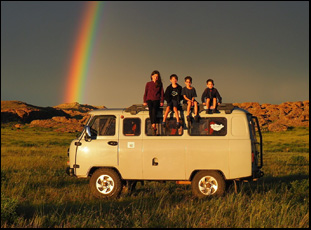
Yeah, my co-director Daniel Roher was contacted by a Canadian friend of ours at MRC and they asked us if we would be interested in making it. We’d known about the family’s story on our socials and through various news articles an we jumped to the chance to make it, but it wasn’t until maybe six months into their trip that we joined them on the first shoot. What was interesting was moving away from a travelogue element of the film. Given the team we had, we always knew we could build an interesting visual landscape of the natural world, but what we wanted to do was find the emotional core of the film and what really connected me to the story was knowing that we could tell a more universal story about letting go, about grieving a future you thought you had, but might now be different. Finding that universal human truth that was outside of visual impairment or the specificity of the diagnosis itself made the film really interesting for us.
If the trip had already started, what was it like to get to know them?
By that point, they’d already become relatively comfortable with the nature of how they were traveling, so they were pretty relaxed. Our first challenge and what we spent time doing was just getting to know the family before we filmed because we realized we needed to get close to the kids if we wanted the audience to feel like they were part of something intimate and that we were just another member of the family.
There’s a wonderful joke at some point in the movie about the sound guy being able to watch after the kids and not that this wouldn’t be a consideration on any of your shoots, but what was it like to put together the right crew for this when you had to have such sensitivity?
Yeah, this was a film made up of a lot of family and friends in the metaphorical sense. I’ve worked on many films together with Daniel and Jean-Sébastien Francoeur, the director of photography on the film who is Quebecois himself [like the Pelletiers]. I knew he’s so incredible with children and so gifted a storyteller individually as a person that he’d be able to capture not only the beauty of the natural world, but also get to know the kids in a way that felt authentic. And it didn’t take long for that to happen. The kids came up with nicknames for the crew. I was the giraffe because of how tall I am and our sound guy was the jellyfish because they couldn’t pronounce the second name.
On the one hand, we picked people who are very relaxed and able to integrate with the family and used to that kind of chaos, which is quite high with four kids. But on the other, our challenge was to meet the family where they were on that emotional journey with retinitis pigmentosa. That meant if we were dealing with difficult subject matter, I was very cognizant of not wanting to push the kids into emotional territory that they weren’t ready for because that’s not my place as a filmmaker. I’m not their therapist. I’m not qualified to be having those conversations with them or talking it through, nor did they want to, so it was just a question of letting these things come out organically and then helping letting that help tell our story. We were very attentive to that.

Yeah, Jean, Daniel and I had several conversations before about the look and the feel of the film and two things came to us. It was that if we were going to move past the travelogue, it meant that we had to make the audience care about the everyday experiences of these kids in this family on a very granular level, so we realized that it was about finding visual references that helped guide us in the film we wanted to make. We turned often to fiction for that. The most obvious example of someone who whose camerawork inspired me was the way the kids are handled in Terrence Malick’s “Tree of Life,” Obviously, that’s a film that’s perhaps more liberally poetic with how it treats childhood, but it gave us the basis of how we want the childhood to feel. We want the camera to be so with the kids that you feel part of their universe.
The family must’ve shot a fair bit of material themselves since you’ve got footage from before the trip. What was it like to sift through?
It was overwhelming for our associate editor Rochelle Hamilton, who had to go through [approximately] 175 hours of the family’s home videos. But what you see in the film is 80 to 90 percent or our footage — we used certain moments and clips to just double down on the intimacy of certain scenes in the film. Obviously, it makes its most pronounced appearance in the cable car…
That becomes such a critical moment in the film. What was it like to realize you even had a moment like that on your hands?
It’s so strange because I’m at home on a Saturday night at 7pm, watching a movie with my partner and I get this phone call from Seb [Pelletier] and he’s two hours into the ordeal at this point [on the cable car]. And he calls me and said, in this very jokey way, “Ed, this is cinematic drama right here.” [He made clear] they’re not going to be in the cable car for 10 hours, but I had to scramble at that point — our whole team did — to find a camera person in Quito, who hiked up the mountain with firemen and women, so as to be able to get those incredibly moody, ominous shots you see of the cable car just hanging in the abyss.
The rest of the footage was shot by Edith and I think it served two purposes. It was a way for her to calm her nerves in the situation, [giving] her that necessary tool you need as a parent to find something to ground you in a reality and make sure that your kids absorb the emotions that you’re putting out into the world, which is ultimately like, “Wow, we’ll figure this out.” And editorially speaking, it’s the kind of scene that is the magic of documentary cinema. I didn’t know what had been shot and our first editor Ryan Mullins got hold of the footage — he looked through most of it when he started working on the film — and he chose this scene in particular, because he felt it stood in for a lot of things about the film. So he said to me and Daniel, “Let me have a go with this,” and we gave him our broad stroke ideas [for the structure], but he came back to us with this incredibly moving, tense scene and we just couldn’t believe how much the scene had offered us. It was actually quite shocking to us like, “Wow, Edith got this scene, and it was really one of those wonderful, serendipitous — also terrible — moments for the family.
It’s quite extraordinary in all those ways. When you’re in the thick of this, was there anything that really came to the fore upon looking at the footage once you got back from your travels with the family?
I always felt as filmmakers we knew what emotional journey we wanted, but with documentary filmmaking, it’s always a question of letting the editors redirect the film afterwards because it’s such a collaborative process. We had a strong sense of which trips we wanted to go on and we knew that we got that best mostly from from our footage. Daniel and I had an idea that this travel itself would need to interact with a lot more home footage to make the story work because when I first heard about the story, my first thought was, “This is about memory and memory is this fragmentary thing. Maybe there’s a world in which we’re following them in the present day and elements of the present day are invoking parts of the trip.” When we tried to tell that version of the story, and we shot a lot with the family in Montreal, for whatever reason, it just didn’t work. It felt repetitive when we watched the film. So it was only at that moment that we turned to the travel itself and tried to turn [these trips] into these almost self-contained pockets that told a larger emotional story.
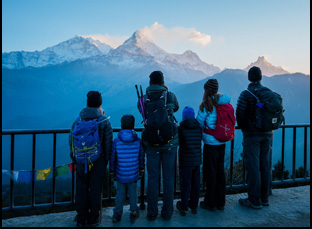
I think Edith did in the sense that she ended up writing a book about her experiences, which obviously takes a slightly different view to ours. They only saw the film at final cut and it was a lot of the conversations that we had with them. Some of the voiceover snippets that you hear is actually just from the master interviews, which did happen after the trip had been over, but in terms of their engaging with the material, they didn’t do so until essentially picture lock right at the end, which as you can imagine, is an incredibly nerve wracking time to show.
What was that moment like and just getting this out into the world now in general?
You always want your subjects to understand that they’re going to see a version of themselves on screen that’s very much from your perspective, but saying that and having it understood are two very different things and we were lucky in that Edith and Sebastien were able to recognize that this was mine and Daniel’s take on their experience, but also feel honored enough that we’ve done justice to their family. Of course, it was delicate and you can never know what people are going to say.
In terms of reactions, what I’ve been so wonderfully pleasantly surprised by is that we’ve had a lot of kids watch this film. A bunch of high schoolers watched it in Telluride and I think at Camden too. We’re playing in Vancouver at the moment and a whole truckload of high school students are watching the film, and what we’ve experienced is kids are really engaging with this film and seem to be seeing some of their own experiences in however minor a fashion on screen. That’s really touched me to feel like you never know. You think a documentary audience is typically adult, and to see that this seems to be resonating multi-generationally bodes well. I’m hoping that families come out to our theatrical release this week and know that they can all enjoy a part of the film.
“Blink” will open across the country on October 4th.
